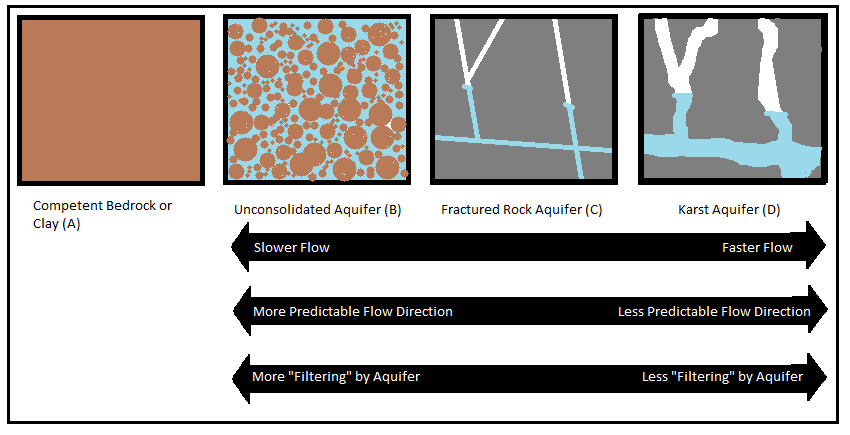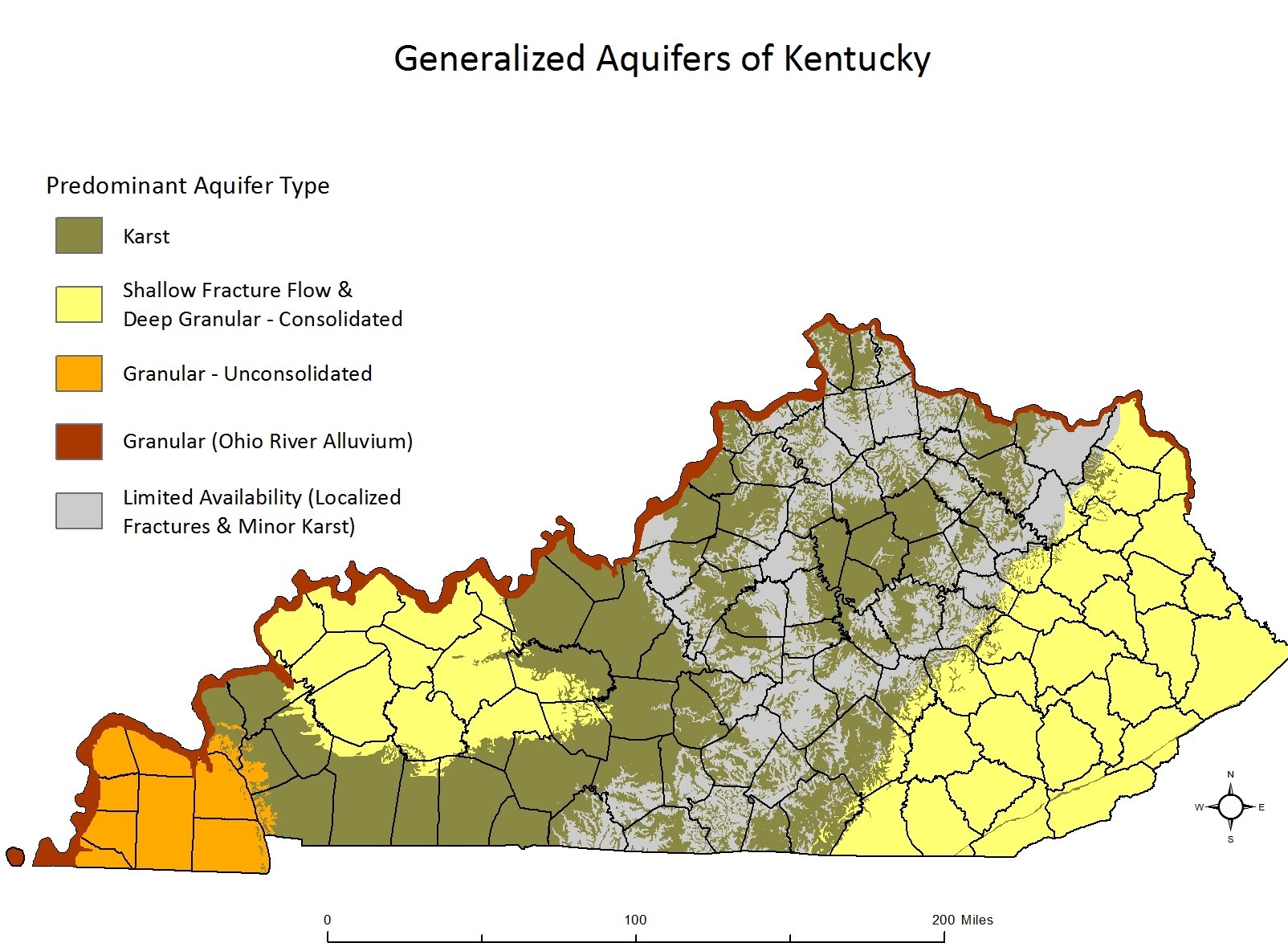Basics of Groundwater and Kentucky Aquifers
Groundwater is a vital resource to Kentucky. It is used for drinking water, crop irrigation, and industrial use, and also maintains flow in our streams during dry seasons. Understanding the basics of groundwater enables us to not only utilize this resource, but also how to protect it. Not all groundwater in Kentucky behaves the same way. Due to unique geology, different areas and regions have groundwater with unique flow patterns. These variations lead to differences in available quantity and susceptibility to pollution. The portion of rainwater that soaks into the ground is the starting point for most groundwater in Kentucky. This newly soaked in rainwater will flow through the soils, sediments, and rocks at different speeds. Some geologic settings do a better job filtering out any potential contaminants than others.
One important groundwater concept to understand is the difference between porosity and permeability. Porosity describes the amount of open space in the rocks and sediments where groundwater can be held, much like water in a sponge. Permeability describes the degree to which those open spaces are interconnected. Interconnectedness allows groundwater to flow more freely. The diagram below illustrates a simplified version of the most common types of aquifers in Kentucky. Competent bedrock, clay layers, and shale (A) have little
 Diagram illustrating the different types of aquifers in Kentucky. Competent bedrock or clay (A) has little to no permeability and therefore little to no useable water. The aquifers on the right are more susceptible to groundwater pollution while aquifers on the left are less susceptible.
Diagram illustrating the different types of aquifers in Kentucky. Competent bedrock or clay (A) has little to no permeability and therefore little to no useable water. The aquifers on the right are more susceptible to groundwater pollution while aquifers on the left are less susceptible.
to no usable groundwater due to very low permeability. Unconsolidated aquifers (B) consist of individual grains of sediment that the water has to flow around and are commonly found along rivers and creeks in Kentucky. Fractured rock aquifers (C) are composed of bedrock that has been faulted and cracked by various geologic forces. Water in these aquifers flows through the fractures rather than through the bedrock. Karst aquifers (D) are similar to fractured rock aquifers except that the fractures have been enlarged by the dissolving of the rock. This dissolution process creates larger passageways where water can flow through at much faster velocities. The map below shows the locations of the various aquifer types found in Kentucky. Each aquifer type is discussed in more detail below.
 Map illustrating the locations of predominant aquifer types in Kentucky.
Map illustrating the locations of predominant aquifer types in Kentucky.
Unconsolidated aquifers are composed of individual grains of sediment that have not been cemented together to form rocks. The individual grains of sediment can be as small as clay or silt or as large as sand, gravel, or boulders. These aquifers will commonly have a mix of sediment sizes occurring in different layers, with clay layers producing minimal groundwater and layers of larger particle sizes producing the most groundwater. Groundwater velocities in these types of aquifers are very slow and generally measured in inches or feet per year. These aquifers can be formed by rivers depositing sediments in floodplains, sediments deposited by lakes and oceans, or outwash from glaciers. The most prolific aquifers of this type in Kentucky are the Ohio River Alluvial Aquifer and the Mississippi Embayment Aquifers of the Jackson Purchase Region. Large quantities of water that need little treatment are commonplace in these aquifers, making it ideal for domestic, agricultural, industrial, and municipal drinking water supplies.
Fracture flow aquifers store and transmit groundwater within fractures found in the bedrock. Fractures in bedrock form through faulting and other geologic processes, such as stress relief. Fracture flow aquifers are highly variable in nature and can differ depending on how and where they formed. The size, number, and interconnectivity of these fractures control the amount and availability of groundwater. Fracture flow aquifers may be less reliable sources of water than some other aquifer types (i.e. granular aquifers) due to the variability in recharge, the quantity of water they can store, and the regional geology. However, some fracture flow aquifers are successfully utilized as drinking water sources in Kentucky. Groundwater velocities in fracture flow aquifers are generally measured in feet per day. The best examples of fracture flow aquifers in the state are found in the Eastern and Western Coalfield regions. Here various geologic processes have produced fractures within Pennsylvanian sandstone, shale and coal units. The Breathitt Sandstone in particular is a fracture flow aquifer that is utilized by public water works, private water well owners, and farmers across Eastern and Western Kentucky.
Karst is a term used to describe the landforms and groundwater flow of areas characterized by sinkholes, springs, and caves. It forms in regions where rocks, such as limestone and dolostone, are chemically dissolved by water forming large passageways and caves. These sorts of features allow for rapid groundwater flow in unpredictable directions, and offers limited natural filtration by the aquifer. Groundwater velocities in karst aquifers are typically measured in miles per day. All of these factors make these areas very susceptible to groundwater pollution. The two major karst regions in Kentucky are the Mississippian Plateau and the Bluegrass Region, both of which host major agricultural industry. Farmers in these areas often utilize groundwater from springs and wells to water livestock or irrigate their crops. Additionally, numerous springs in Kentucky are used for domestic and municipal drinking water supplies. Perhaps the most famous karst setting in the world is Mammoth Cave, located in south central Kentucky.
To highlight the difference in these aquifers as it relates to pollution, take a pasture with livestock grazing as an example. Animal waste containing bacteria will be present. Escherichia coli (E. coli), the most common bacteria in animal waste, does not survive very long underground. In a fast flowing aquifer, such as karst, E. coli would be quickly transported from the surface, through the aquifer to a well or spring, without enough time in the aquifer for the bacteria to die. On the other hand, E. coli flowing through an unconsolidated aquifer would be moving slower, and would probably not survive long enough to reach a water well. The person utilizing the karst aquifer could still utilize the groundwater affected by E. coli, but it is recommended that the water be treated for pathogens and possibly other contaminants.
Another consideration is that soil also factors into the quality of the water. Different types and thicknesses of soil, and the helpful microbes and vegetation contained within, will “treat” the water to different degrees. All of these factors are unique to different areas of Kentucky and are factored into the determination of the hydrogeologic sensitivity of an area. To learn more about groundwater sensitivity regions in Kentucky, see this map
GWsensitivity.pdf (uky.edu).
By learning about the basics of groundwater flow and common aquifers in Kentucky, you will understand the importance of protecting this valuable resource in Kentucky. Please contact the Groundwater Section of the Division of Water for questions about aquifer types in your area, how to find a water well driller, treatment tips for your groundwater, and any other information or assistance about this resource.
What Can You Do To Protect Groundwater?
The links below provide additional information about steps that citizens can take to protect this valuable resource.